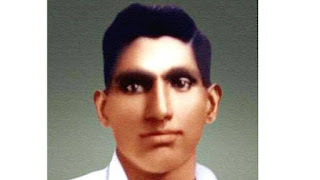Q.1.- Ibrahim Lodhi was defeated by Rana Sanga in which of the following battles?
(a) Battle of Khatoli
(b) Battle of Gagron
(c) Battle of Khanwa
(d) None of the above
Q.2.- Who among the following Delhi Sultanate rulers was first to have coins inscribed with the name of Abbasid caliph of Baghdad?
(a) Iltutmish
(b) Ruknuddin Firoz
(c) Razia
(d) None of the above
Q.3.- Chintamani Bhatta’s Suka-saptati (Parrot’s Seventy) was the first Sanskrit work to be translated into Persian by the name Tutinama. Who translated the work during the time of Mohammad-bin-Tughlaq?
(a) Malik Muhammad Jayasi
(b) Amir Khusrau
(c) Zia Nakhshabi
(d) Zain-ul-Abidin
Q.4.- The Quwwat-ul-Islam mosque in Delhi is the earliest example of Islamic architecture in India. What was the original construction at the site of the Quwwat-ul-Islam mosque?
(a) A Jain temple
(b) A Hindu temple dedicated to Vishnu
(c) A Hindu temple dedicated to Shiva
(d) None of the above
Q.5.- Which of the following rulers of Delhi Sultanate created the department of Diwan-e-Amir-Kohi related to agriculture?
(a) Firoz Shah Tughluq
(b) Muhammd Bin Tughlaq
(c) Allaudin Khilji
(d) Jalauddin Khilji
Q.6.- Who among the following Delhi Sultanate rulers had appointed lbn Batuta as the Chief Oazi of Delhi?
(a) Balban
(b) Alauddin Khilji
(c) Feroz Shah Tughlaq
(d) Muhammad bid Tughluq
Q.7.- Which of the following rulers of Delhi Sultanate had maximum number of slaves in his court?
(a) Balban
(b) Alauddin Khilji
(c) Mohammad bin Tughlaq
(d) Feroz Shah Tughlaq
Q.8. - Who among the following was the ruler of Delhi Sultanate when Hari Har and Bukka founded the Vijayanagar Empire in the South India?
(a) Muhammad bin Tughlaq
(b) Firuz Shah Tughlaq
(c) Alauddin Khilji
(d) Khizr Khan
Q.9. -Tarikh-i-Firuz Shahi has been written by
(a) Ziauddin Barani
(b) Shams Siraj Afif
(c) Both a and b
(d) None of the above
Q.10. -During the reign of which Tughlaq ruler, India faced invasion from Amir Timur, the terrible Mongol military leader of Central Asia?
(a) Ghiyasud-din Tughlaq
(b) Firuz Shah Tughlaq
(c) Muhammad bin Tughluq
(d) Nasiruddin Mahmud Shah Tughluq
Answers
Q.1.- (a)
Battle of Khatoli was fought between Rana Sanga and Ibrahim Lodi in 1518. Rana Sanga defeated Ibrahim Lodi in the battle of Khatoli.
Q. 2.- (a)
In 1229, Iltutmish received a deed of investiture from the Abassid Caliph of Baghdad, becoming the first Sultan of Delhi to secure this recognition. The names of Abbasid caliph of Baghdad are inscribed on his coins.
Q. 3.- (c)
Zia Nakhshabi (d.1350) was a famous Sufi saint and scholar during the reign of Tughlaq Sultan Muhammad bin Tughlaq. He is credited with translating Chintamani Bhatta’s Sanskrit work Suka-saptati (Parrot’s Seventy) into Persian. The text translated by him is known as Tutinama (Stories from a Parrot) which was in time translated into Turkish and other European languages.
Zia Nakhshabi had also translated Koka-shastra (also known as Rati-rahasyam: Mysteries of Passion), a popular early medieval Sanskrit work on erotica written by Kukkoka (Kokapandita).
Q. 4.- (a)
Quwwat-ul-Islam mosque in Delhi is considered to be India's oldest mosque.
Q.5.- (b)
The department named Diwan-e-Amir-Kohi was introduced by Muhammad Bin Tughlaq.
Q.6.- (d)
Arab traveller Ibn Battutah arrived in India in 1333 during the rule of second Tughlaq ruler Muhammad bid Tughluq who appointed him the Qazi (judge) of Delhi. After serving for eight years as the Qazi (judge) of Delhi, he was dismissed from the post by the Tughlaq Sultan.
Q.7.- (d)
Feroz Shah Tughlaq is known to have as many as 180,000 slaves. According to Shams Siraj Afif, their rise brought disaster to the Tughlaqs. They annihilated Firuz's sons and played roles in destroying the Tughlaq dynasty. Firuz's eunuch named Malik Sarwar founded the Sharqi dynasty of Jaunpur.
Q.8.- (a)
During his reign Muhammad bin Tughluq had to encounter as many as thirty four rebellions, twenty seven of them in the south. Vijayanagar Empire came into existence at the cost of Sultanate territory during the rule of Muhammad bin Tughlaq.
Q.9.- (c)
Tarikh-i-Firuz Shahi is a contemporary account of Sultan Firuz Shah Tughlaq by medieval historian Ziauddin Barani. Another contemporary chronicle, also known as Tarikh-i-Firuz Shahi, written by Shams Siraj Afif, gives a detailed account of his reign.
Q.10.- (d)
It was during the reign of last Tughluq ruler Nasiruddin Mahmud (reigned 1394-1413) in the years 1398-99 that Amir Timur, the terrible Mongol military leader of Central Asia, invaded India creating havoc in the forms of massacres and plunders.




